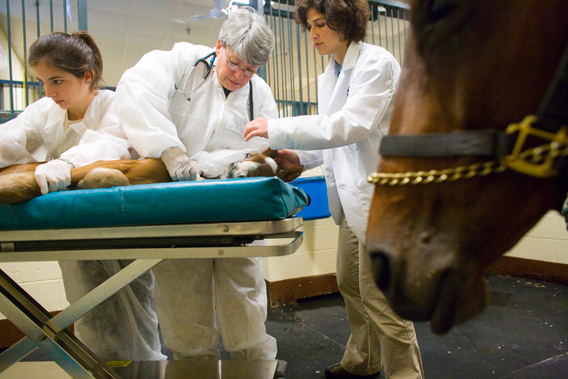Is There a Veterinarian in the House?
Study predicts a shortage in New England of vets, who add some $3.3 billion to the regional economy
The New England region will be facing a potential shortage of more than 600 veterinarians in six years, according to a study recently released by the Cummings School of Veterinary Medicine. At the same time, the report noted that veterinary medicine contributes $3.3 billion annually to the regional economy.

The New England region will need more veterinarians, according to a new report commissioned by the Cummings School. Here, Associate Professor Mary Rose Paradis, center, and her team treat a foal and its mother at the Hospital for Large Animals. Photo: Melody Ko
The study, which was commissioned by the Cummings School and performed by the UMass Donahue Institute, highlights the growing need for veterinarians in the region. New England will have a need for some 1,000 veterinarians by 2014, according to the Bureau of Labor Statistics.
Currently, some 60 percent of students at the Cummings School, the only veterinary school in New England, remain in the region after graduation. If that trend continues, it's likely that 378 of the school's graduates will enter the region's workforce by 2014, leaving 658 new vacancies for veterinarians unfilled.
What's more, the study suggests that the region faces a flood of retirements among veterinarians treating dairy cattle and other food animals. More than 25 percent of the region's specialized food animal veterinarians will reach retirement age by 2014. With current levels of graduates, the Cummings School will be in a position to replace only half of those vacancies.
According to the study, 43 percent of New England veterinarians are over the age of 50, while 56 percent of livestock veterinarians are in the same age group. The study estimates that those veterinarians will retire during the next six years at nearly twice the rate of veterinarians whose practices focus on pets. With the important role that food animal veterinarians play in protecting the nation's food supply, this shortage is especially alarming, say the report's authors.
"Veterinary programs across the country are increasing enrollment to try and address the need for more graduates, especially in underserved areas such as food animal medicine and public health," says Deborah T. Kochevar, dean of the Cummings School. "These efforts, though, are complicated by the limited capacity of teaching facilities and the lack of capital funds to support expansion."
Boost to the Economy
In addition to raising concerns about potential shortfalls in veterinary practitioners, the report also details the $1.72 billion of direct veterinary expenditures in the region.
Clinical veterinary practices, which provide medical services for household pets, farm and food animals, and exotic animals, represent the largest percentage, with some $1.1 billion, or 65 percent.
The scientific research and development field, which requires animal health and husbandry services to test new drugs and devices and to better understand animal and human health, makes up the next-largest category, with 23 percent of direct veterinary medicine spending.
Laboratory animal veterinarians, for example, are responsible for the welfare of some 2 million laboratory animals in New England. Veterinary academia contributes 9 percent, and nontraditional veterinary medicine, including zoos and humane societies, adds 3 percent to the expenditures total.
"This study confirms the importance and economic impact of veterinary medicine in Massachusetts and New England," says Kochevar.
The study included findings for each state covered. It found, for instance, that Massachusetts has New England's largest veterinary scientific research and development sector, and that more than 5 percent of the state's veterinarians specialize in this area.
The researchers note that Maine has the nation's sixth-highest rate of pet ownership, with 70 percent of households-some 376,000 homes-owning one or more pets. New Hampshire residents spend the second-most in the region on veterinary clinical services per capita, at $94. The Granite State also ranks second in the region in median wages for veterinarians, at $78,180.
The study, titled "Veterinary Medicine in New England: State-by-State Industry Characteristics and Economic Impacts," was supported by the Veterinary Medical Associations of Massachusetts, Connecticut, Maine, New Hampshire, Rhode Island and Vermont, the New England Veterinary Medical Association and InTown Veterinary Group. Hill's Pet Nutrition Inc., was the study's lead industry sponsor.
"In order to best understand the health of the animals in New England, we need to understand the industry that cares for them," says Christine Jenkins, director of academic affairs at Hill's Pet Nutrition. "This study does just that-and we hope it sheds light on the growing need for veterinarians in the workforce to ensure the care and safety of animals in the region."
One of the beneficiaries of a strong veterinary presence is the biomedical industry in Massachusetts.
"In order for the biomedical and medical device fields to continue to thrive in Massachusetts, we must maintain a very high standard for ethics and care in our research divisions," says Kevin O'Sullivan, president and CEO of Massachusetts Biomedical Initiatives. "As such, veterinarians are our greatest resource, and provide a crucial element for the growth of the biotech sector."


